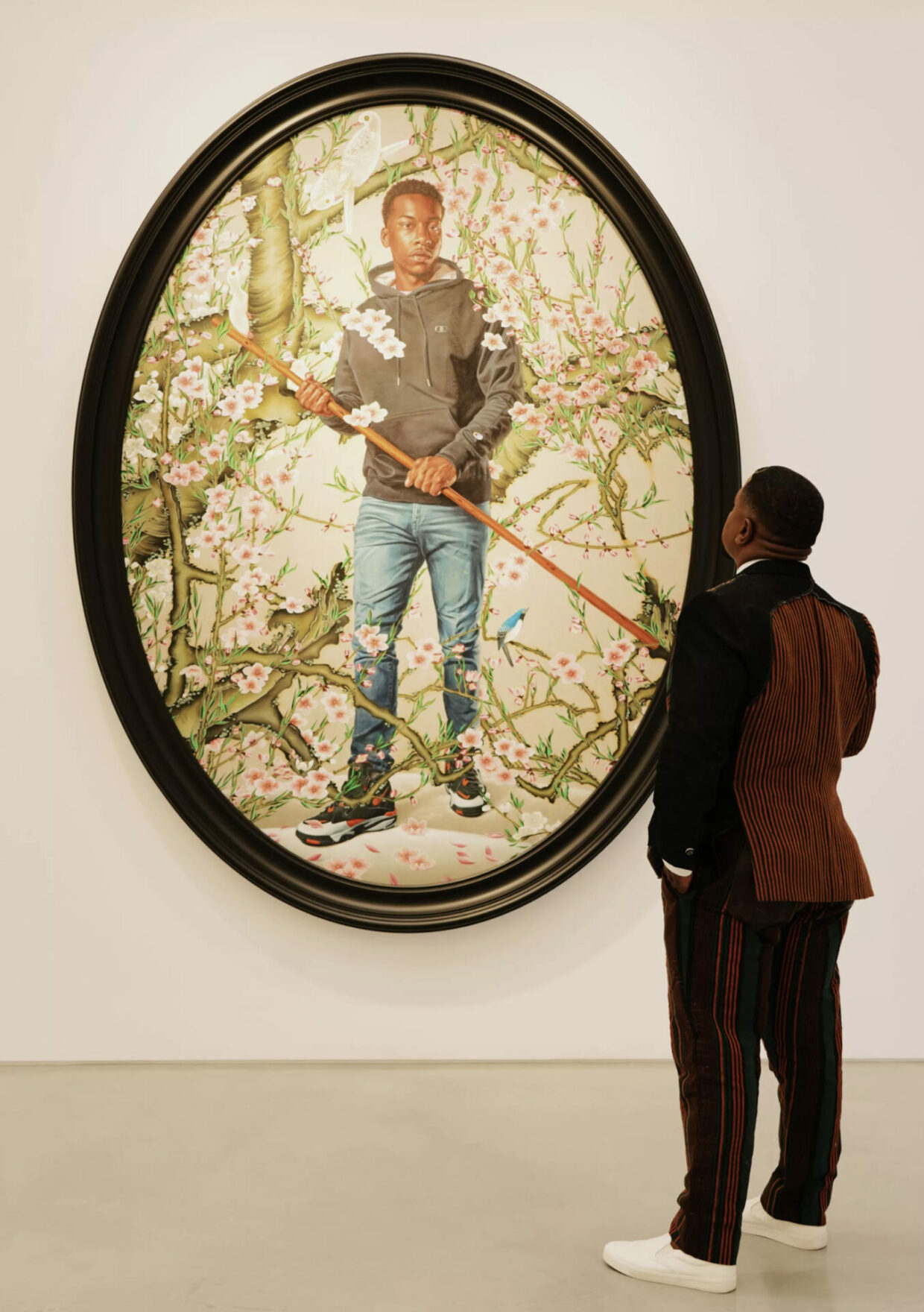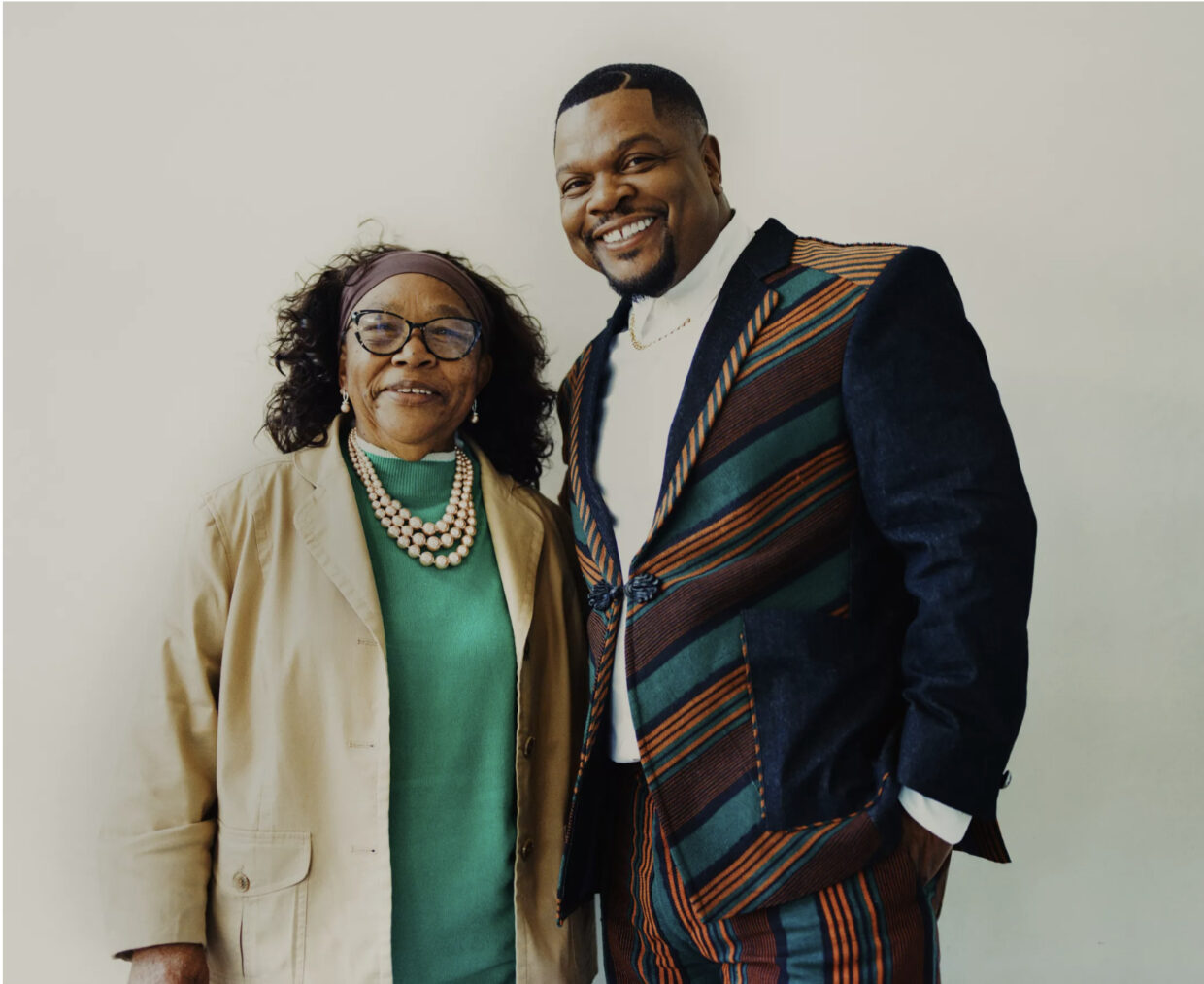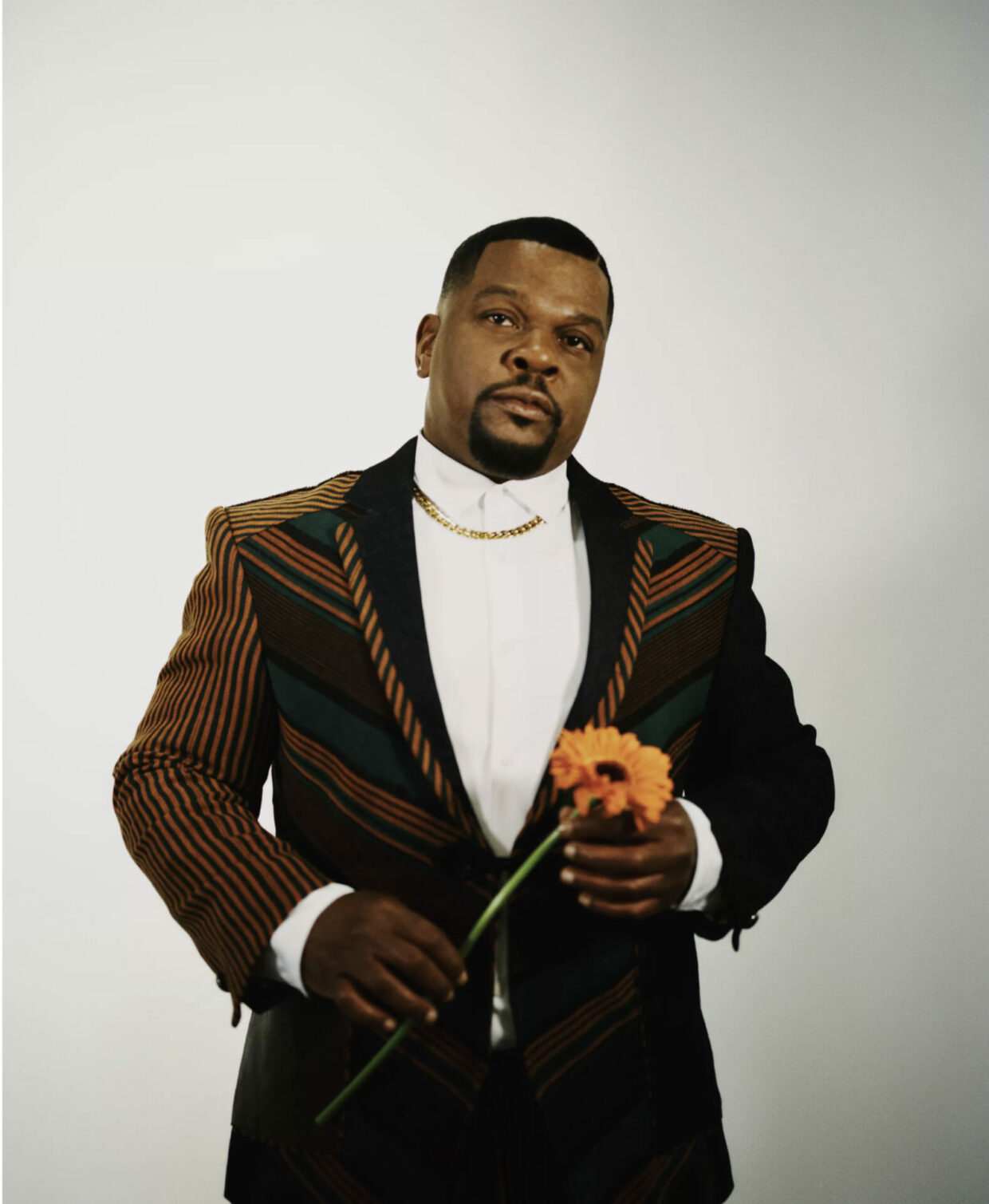Kehinde Wiley is reaching for a new language of grace
Feb. 16, 2023
Kehinde Wiley is ebullient yet poised on the afternoon of our Zoom conversation. The painter — one of contemporary art’s most celebrated — joined from a sunlit room in Roberts Projects, where a new series, “Colorful Realm,” was being prepared to open to the public. We met on the eve of this opening, when, for any artist and their team, every minute is valuable, any small fire may arise. Initially, I expected I would begin our conversation on this note, asking Wiley if it ever gets any easier for him, when a team member popped in to inform me that Wiley was running just a few minutes behind. He had stepped outside to talk to his mom. I grinned, and when Wiley finally appeared on the screen, I knew where we’d begin: with Ms. Freddie Mae Wiley.
It is no stretch to say that Ms. Freddie Mae was Wiley’s first source of creative inspiration; it was she who showed him the liberation, “the radical possibility,” offered by a creative life. Through her travels and collector’s impulse, Wiley learned to appreciate not just the beauty and artistic possibility of the objects around him but the joy and pleasure that comes from gathering loved ones in the spirit of righteous community. In fact, the paintings that comprise “Colorful Realm” are formally and conceptually inspired by Wiley’s study of Edo period Japan, a region introduced to him by his mother, who spent time in the country as a marine.
I imagine that Wiley was so rightfully cheerful to debut a new body of work that extends from and expands his investigations into the complexities of race and gender on the canvas — paintings that vault his sitters into divine landscapes. The work, he tells me, is about “radical freedom,” about that possibility that he first found through Ms. Freddie Mae.
Jessica Lynne: You’ve spoken often and so eloquently about your mother’s creative spirit, imagination and curiosity. To that end, what are the things that she’s teaching you now?
Kehinde Wiley: One of the things that she modeled for us very early in life was the importance of a global presence. She comes from Texas, but during her childhood, she decides to leave Texas. She joins the military and goes to Okinawa, Japan, where she serves as a marine. From there she comes back to the States, serves at Langley and goes to university at UCLA, where she meets my father, who is Nigerian. She spends some time in Nigeria as well.
When I was 12, she sends me off to Russia, and I get this sense that whatever it is that’s immediately in front of me — whether it be economic hurdles or social circumstances that are going on — is just part of a much broader global fabric that we’re all tied to.
I think that helped save me in many ways. It made everything feel temporary and endurable, and it allowed me to dream in a way. There’s so much about her influence in my life that has to do with fantasy. She created these amazing gardens that my brothers and sisters and I grew up around. There were sculptures in there. There were antiques in there and plants growing all over the place. It was this real installation project inside of a greenhouse. This experience of being surrounded by something that was an invention — that was beautiful, that could be tended and mined and changed at will — is really the beginning of my aesthetic awakening. All these years later, I think that explains a lot of my creative DNA.
JL: Do you consider your mother to be an artist?
KW: Certainly. We were just joking today about me spending more time in her museum. She calls her house her museum because she has an amazing collection of objects. Also, I think that it’s more about a state of mind, more than anything. Duchamp tells us this: The way in which you look at an object is the art practice. I was always being encouraged to look at the possibility in objects. The possibility for refurbishing something and putting it out on the street and selling it. Or the possibility of putting a layer of paint on something and painting a few flowers and angels on it. I think that’s ultimately what she was able to engender: this sense of radical possibility.
JL: How are you thinking about your own legacy and the folks that you’re inviting to be part of that legacy, be it through your residency in Dakar or via the community of artists that you work alongside?
KW: Community is something that is invented and inherited. It’s a stream of what came before us and what we choose to intervene in and make ourselves. There’s the family that you have, in terms of a genetic family, but there’s also a chosen family. I think so much of what I do is create this fusing or galvanization of my given and chosen families, and try to create a broader set of circles that can start in America and increasingly go out into the world.
My model was the Studio Museum in Harlem, where I spent so much of my time as a young man coming out of the university. I was lucky enough to get a spot in their artists-in-residency program. There were exactly three artists and there’s exactly three artists in Black Rock. It was an incredible experience because that number of three allowed us to be a small enough group to feel vulnerable and large enough to be able to go off in our ways and have an ability to be alone and explore our creative practices as well. So, all these years later, when I was given a chance to think about what kind of contribution I wanted to make to the arts community, I thought it was really important to be able to echo my experience and my gratitude for Thelma Golden, Lowery Stokes Sims, Christine Kim, all those women who surrounded me and allowed me to feel powerful when I first arrived in New York.
JL: You use the word “luck” and you use the word “chance,” and I also wonder where and how surprise shows up for you, whether in your artistic practice or your cultural organizing through the residency.
KW: The type of work that I do is so deliberate. It requires meticulous painting technique, digital intervention and the setting up of shoots and teams. By the time you’ve arrived at the actual act of painting, that becomes a much more fixed experience. I think that surprise comes in these happenstance moments that I try to create by throwing myself into the streets of London, São Paulo, Brooklyn, Lagos, and just allowing the sheer flow of humanity to come at me. Or in the colors and the textures of what young people happen to be wearing in the early 2000s versus 2023. The ways in which people want to be able to find grace and dignity and look fly and fall in love is something that changes and evolves over time, but it’s constantly following a certain set of desires and patterns as well. There’s something really cool about being able to be surprised simply by the act of waking up and walking on the streets.
I think what I try to do, as well, is interrogate the history of Western easel painting in a way that allows me to play to its strengths, to play to some of the parts that have, perhaps, decayed over time, and to pull out some of the dusty old language of museum vernacular and try to breathe fresh life and light into it. It’s amazing how that can happen by simply nodding towards people who happen to look like me or nodding towards experiences and states of grace that are sadly missing from the great museum walls across the world.
JL: A word that comes to mind when I think about your work is “devotion,” in that your paintings, for me, invite a sense of devotion on the part of viewers for all the reasons that you’ve just outlined: formal choices, the engagement with the histories of the medium of painting. In thinking about “Colorful Realm,” how have you reflected on the sensation of the divine and in what ways has that sensation shifted with this new body of work?
KW: You’re talking about my relationship to the divine as shot through the vocabulary of art history. I’ve been constantly riffing on what it means to be in a state of grace, and that’s oftentimes pictured in religious paintings as white light associated with the heavens and moments of the divine. You can see it in Tiepolo’s ceiling frescoes quite often. Actualization starts to become a metaphor that’s driven by whiteness.I think it’s important to recognize that there are other ways of reaching the language of grace. Oftentimes, if you look outside of Western art, such as Edo period painting, you start to see that space itself and nature itself becomes a stand-in for the divine.Going back to my mom and her relationship to Japan, there has been this fascination with Japan by virtue of the food that she would cook for us. There was this fascination that was strangely given to me through the stories of a Black woman. What I wanted to do with this body of work was create, at once, an exploration of all of the individual characters and their personalities and their quirks and the way that they like to dress, but also how they all fit in this vast, almost religious space, and the freedom that it opportunes — a kind of radical freedom that’s completely divorced from these Western notions of being fixed in terms of race, or in terms of gender, or class. All of these categories that clip our wings in terms of the way that we see ourselves, potentially, in the world.This body of work is about radical freedom, shot through the rubric of Edo period painting, that is only ever arrived at through my investigations of Western Christian painting that predate this body of work.
JL: What brought you specifically to the work of Itō Jakuchū? Has he been a figure for you lingering in the background of your study and research?
KW: When I was exploring Edo period painting, I wanted to be able to create work that was a nod towards an individual but also a nod towards an entire stylistic tendency of a time and region. It wasn’t about paying homage to a specific artist but rather paying homage to a way of thinking or a way of navigating or picturing space and the human body’s relationship to it.Much of the work that I’ve been doing lately has been an investigation into the way that the white Western imagination has had this deeply problematic consumer/consumed dichotomy with nature. There is this dynamic of nature as being something that carries great potential and therefore can be bought, gridded and sectioned off. I love the idea of breaking out conceptually from a Western way of thinking about wilderness and landscape and the potential that offers the Black body.Is it ever possible to see yourself outside of the calculus of the savage, the calculus of a tropical people who are, at their best, naturally inclined towards antisocial behaviors, hypersexuality, etc.? I don’t know if that’s ever even possible, but the desire is perhaps the subject matter of their work more than anything.
JL: There’s something about the way Western conceptions of nature implicate a desire for possession and capture, and part of what I hear in your response questions what it means to refuse that and position, visually and conceptually, Black folks beyond this realm.
KW: But I think I’m saying, at the same time, that it’s impossible to refuse that. We’re all somehow bound within the facts of history. By looking at these paintings, what you’re seeing is a desire to escape the nature of Western easel painting; but it’s a gesture, an itch and a desire to scratch it, but ultimately it’s never scratched. I think to create that anxiety as the subject matter of your work arrives at something, and that itself is a worthy truth.
JL: Did you ever contemplate your own relationship to L.A. as you were making these works, especially given the ecological catastrophes and disasters that the city is mitigating? If so, how and to what extent does that contemplation factor into this itch or gesture that you refer to? I could also ask the same thing about a city like Dakar, which I know is a home to you, that is also managing and navigating disaster in this way.
KW: There’s something that heightens the precious nature of anything when you see it under threat. There’s a reason why we love to see glorious oil paintings of flowers. It’s because they simply decay, and then the painting is a hedge against that. The portrait itself is a hedge against death. It’s a recognition that you will never be this young and resplendent again. Growing up here in Los Angeles in the ’80s and ’90s, I remember some of the most amazing, fever-dream sunsets that were brought to you by virtue of smog. There is a sadness that surrounds the loss, and I think art certainly has a role in helping us to appreciate what we have, by virtue of fetishizing what is there and, by virtue of its fetishization, pointing to the vulnerability of it as well.
JL: I want to ask about the nature of spectacle. One of the things I’ve been struggling with is what it means to assign reverence to a community or a group of people, and make beautiful the most quotidian aspects of our lives — I’m speaking here specifically about Black folks — as these works are consumed by folks who aren’t Black or who don’t have a relationship to Black life. I wonder if that consumption simply results in skewed understandings of Black life, across class, across gender experience and so forth. Is that something that you ever think about? Is it something that you think, in fact, can be guarded or protected against?
KW: Yes, and no. Again, pointing to the frustration itself is the escape hatch. You reminded me of a body of work that I did in which I encouraged my sitters to smile for hours. This smile slowly became muscle spasms and slowly became this image of suffering. The spectacle of joy is at once the spectacle of the suffering. It is the perfect metaphor for the performance of the self, the performance of the politicized self, which is oftentimes such a thin soup it doesn’t really make you feel fulfilled as an artist because you don’t always want to create politicized work.
It reminds me of this Bas Jan Ader image of him crying and the text underneath it says, “I have so much to say but I just don’t know how to tell you.” There’s the subject of the misery or the search for authenticity, which, no matter what your race, gender, class is, what we all are seeking is the impossibility. I think that there’s a way in which we can be satisfied with the journey as much as the object.
You probably more than anyone know that the act of arriving at a beautiful piece of writing or a beautiful bit of painting is only part of the story. It’s grappling with it that allows you to really have not only a sense of your own work but an appreciation of the work of others, to understand exactly why this is so graceful or why this is so painful or why this is so beautiful. It’s incredibly thin glass, and we’re all walking on it. I think the tightrope act is to be able to keep up the illusion, and the strength is the fragility of this kind of spectacle.
Source: LA TIMES




